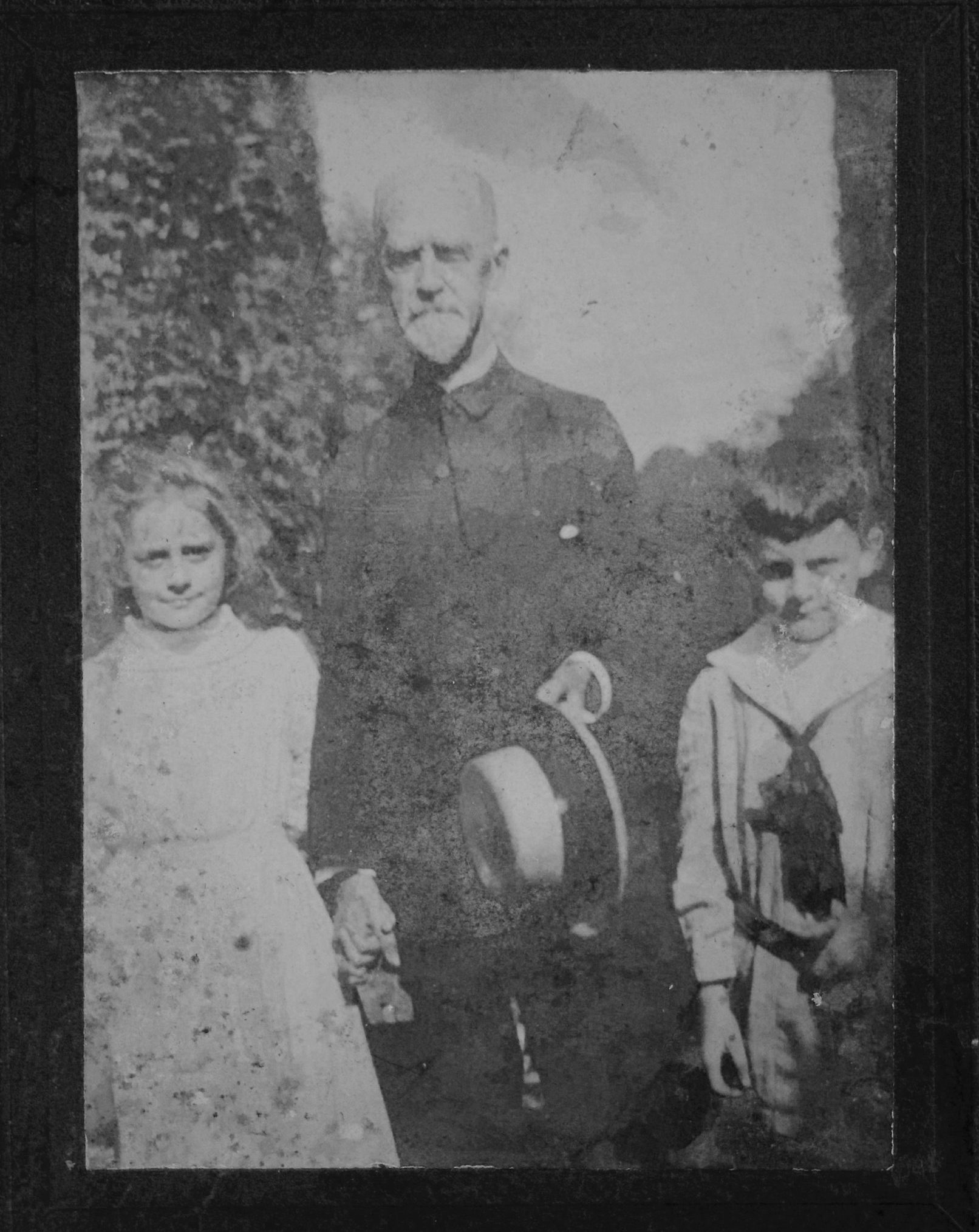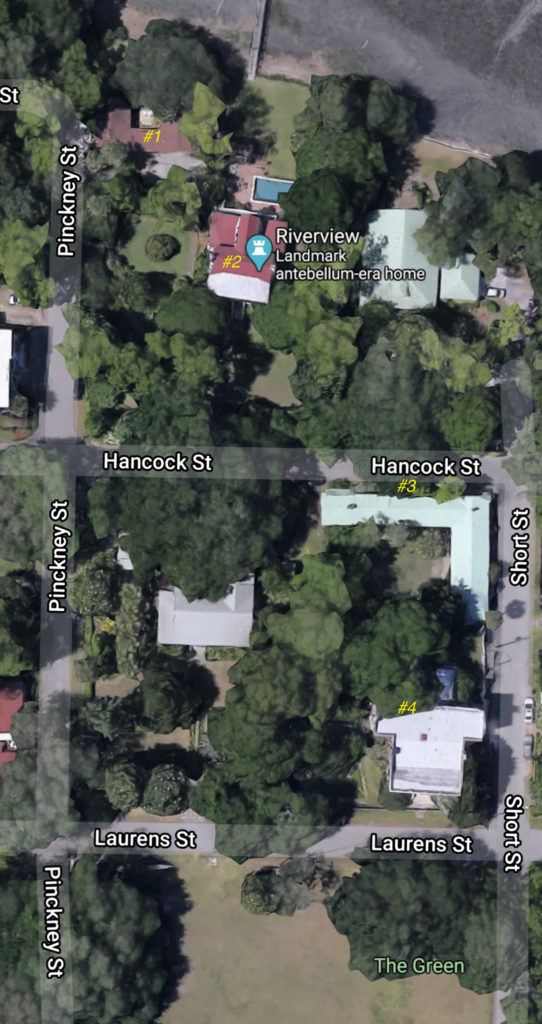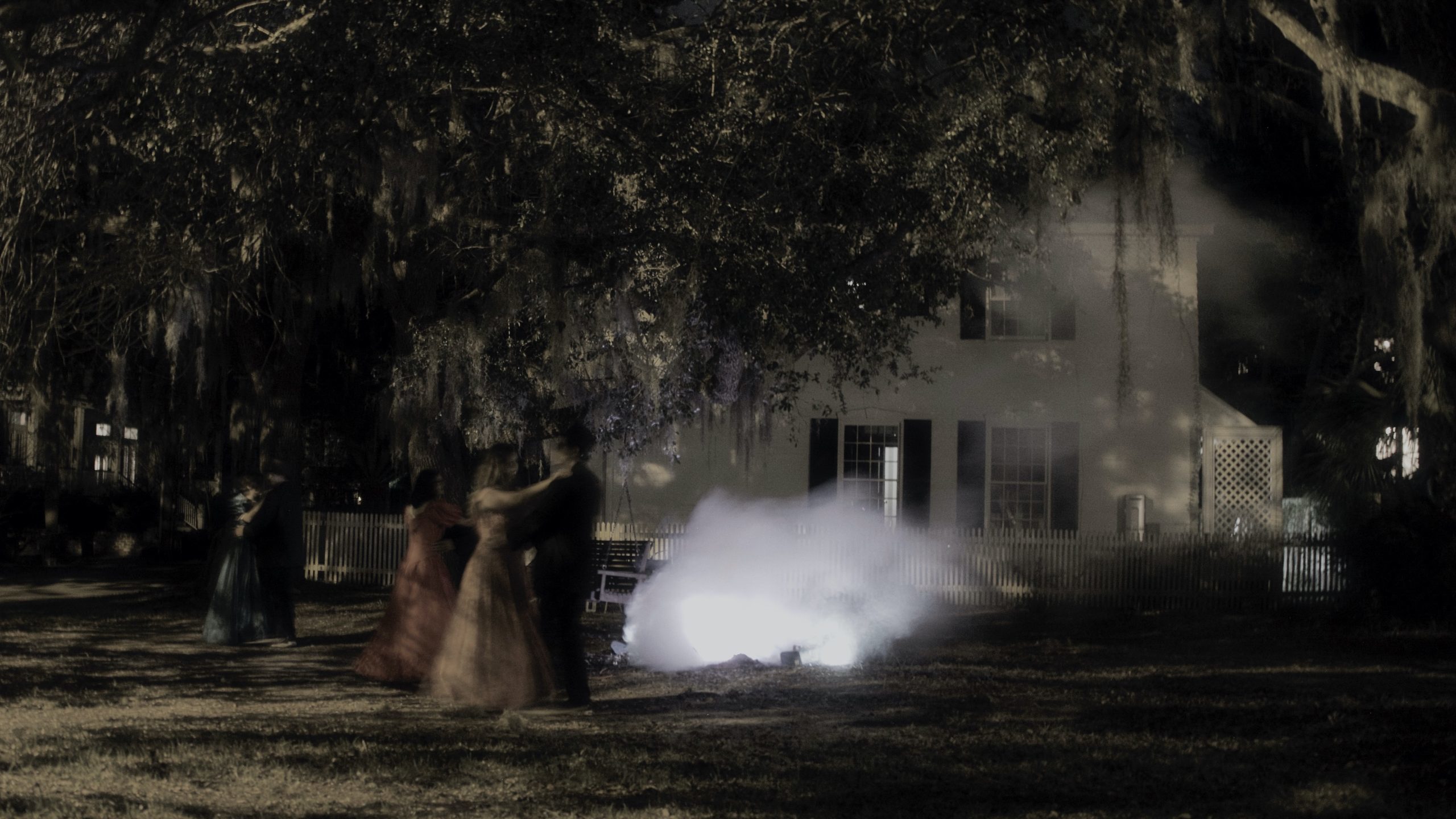The theme this week is SPOOKY. Since Halloween is this week, I thought it would be fun to dig up (ugh!) a few of the scary stories Reverend James Julius Sams included in his memoir about being a kid on Datha Island. So today, I’ll tell you a few spooky stories from the early 1800s. One happened in the Big Woods on Datha Island, one on St. Helena Island, another on Oak Island, and the last in the BB Sams plantation house.
All these stories save one were told by the Reverend James Julius Sams in his unpublished memoir. Julius wrote his memoir in 1905, give or take a few years. At that time, he was 80 years old. Much of his memoir is about the childhood antics of he and his younger brother Horace Hann Sams. He leaves clues as to when these stories occurred. For example, he mentions he was old enough to shoot, but Horace was not. That would put JJ at about 12 years old, and the year as 1838. A few of the stories are based on events that occurred earlier. These tales were passed down to him.
Halloween has its roots in Christianity’s All Souls Day. In the first half of the 19th century, this day in America was associated with the harvest, more so than a day to honor the dead. Public harvest celebrations were common. The festivities included bonfires, ghost stories, and mischief-making of the innocent kind. By then, the name of this ‘day before All Saint’s Day’ had become All-Hallows-Eve or Halloween. This would have been the context in the Sams era in Beaufort. However, it wasn’t until after the Civil War that folks began to dress in costumes and go house-to-house asking for food or money, then eventually candy. To be clear, JJ and Horace would not have known costumes and candy, though they may have gone to a harvest celebration.
The White Lady
JJ’s memoir is about 30 pages long. He gets to the first ‘ghost’ story on page 3. It must have made a real impact on him when he first heard it. The story was passed down to Julius about 20 years after it happened. These are mainly his words, but I’ve done some minor edits—the setting is Datha Island, circa 1815.
“Big Woods was not on our part of the Island [BB Sams southern part, called Datha Inlet] but deserves some notice. It began just over what was known as the Locust Fence, the line dividing the island. It commenced at the fence, and extended down within a half a mile of the other end of the island [LR Sams’ northern part, called Datha Point]. It was called Big Woods in distinction of a smaller body of woods, known as Little Woods. This latter had disappeared before my time. There is a story connected with Big Woods which I might as well tell here. At the time to which I allude, there were two settlements on the island [Datha Point & Datha Inlet]. The negroes were continually passing from one to the other after nightfall. On one occasion they would not leave either settlement except in daylight. On inquiring the reason, it was found that there was a rumor amongst them of a white lady with long hair, who had taken up her abode in these woods, and whenever there was a storm, who would commence to scream and wring her hands. It was impossible to reason them out of this.
At last my Uncle William [William Sams Jr. (1766 – 1817)] told them that the next time they heard the white lady, they must let him know. Accordingly not long after this, a storm of wind happened to rage, and some of the negroes came and reported that the white lady had commenced to scream. Calling his dogs and taking a hatchet, my uncle set out on a search for the white lady. It was at night. Entering the woods and making his way as well as he could in the dark, he followed the sound until he reached a tree from which it seemed to come. He barked the tree with his hatchet and then turned homeward. He passed out of the field and entered that known as Little Woods. Then he said it was his time to be frightened.
Suddenly he heard around him great trampling as of many horses. The conduct of his dogs helped to alarm him. They ran in between his legs again and again, almost tripping him up. At last with yelps they dashed off, never stopping until they reached home. He said it was the first time he ever experienced the sensation of hair standing on end. He never found from what that sound came, nor could he explain the conduct of his dogs in connection with it.
The white lady turned out to be two limbs of a tree which had crossed in contact with each other and, being long, whenever the wind blew they rubbed together and make a shrill, creaking sound. I believe all these so-called mysterious sounds can be traced to natural causes. “
Knocking at The Parsonage
Like the first story, this one also was handed down to Julius as a child. The setting is ‘the parsonage’ on St. Helena Island, circa 1815. I believe he is referring to The Parsonage Plantation which Dr. Lewis Reeve Sams, M.D. eventually acquired from his father, Lewis Reeve Sams, Sr. — or maybe from BB Sams. This plantation was located across the street from today’s Chapel of Ease ruins [Rosengarten]. See Week 17.
“I remember hearing my father tell of a little incident that happened when he was living at the parsonage on St. Helena. It was when he was practicing medicine. He was often called out at night, and my mother complained of a certain strange sound which she never heard except in his absence. The sound proceeded from the lower part of the house, something like a knocking. She did not believe that there was anything supernatural in it, nor did he. Though he tried, it was a long time before he discovered the cause.
One night he was called out and had returned without his servants knowing it. Soon after he entered the house the noise commenced. He listened for some time and then slipping his boots off walked softly out of the house, down the steps, around to a door which opened into a cellar. He caught sight of some dark object within. Springing forward he grasped one of his own servants. It seems his servants were dissatisfied with staying there and hoped by alarming my mother to induce a move back to Datha.”
Scary Owls on Oak Island
This story is a first person account of an adventure that Julius had with his younger brother Horace. The setting is Oak Island, circa 1840.
“This reminds me of an early adventure on that island with my brother Horace. If I am not mistaken, we had gone there to cut a palmetto cabbage. I had just learned to shoot, he not yet. I carried the gun, he the ax. We left the house rather late in the afternoon. By the time we reached the island day was well-nigh gone, and night was coming on. The ducks had left the ponds. The last flock of Curlews had passed over. The doves had commenced to gather around the little ponds in Oak Island which they always did about sun set, the negroes had left the adjoining field, the cows, hogs and sheep had all gone home, not even the call of the cowboy shouting at some stray member of the flock, ya-e-e-e.
There was a still and somber look about everything. “Horace, you are not afraid?” “Afraid? Not I”, “No, not I either”. Thus we tried to bolster each other up. Of what should we be afraid? There was nothing to harm us. Even if so, we had a gun and an ax. We marched on, and marched in. After proceeding a little distance an owl commenced to hoot. Neither of us liked the sound. We would have enjoyed it more if we had been seated in the Piazza of the west house. We both had a kind of feeling that the ill-omened bird was laughing at us as though it had caught us in a trap by ourselves, and our day had come; our night. However, we both knew it was only an owl, and that it was really more afraid of us than we were of it.
I rallied therefore and determined to put my best foot foremost, and attack his owlship. When I look back and take in all the circumstances, I am a little surprised at my own resolution and his agreeing. I stopped, told him to stand where he was and watch to see whether the owl would fly, should he cross the road after I had passed on. It had darkened more. The music of the owl had not become any more pleasant to us than to the squirrel. I went on softly, leaving Horace as I thought behind in the road and on the watch. I walked on, peering with my eyes into the palmetto pines and oaks on either side, to see if I could see his owlship and get a shot.
After a while I heard a slight foot fall, and looking behind whom should I see but Horace, who scared me as much as if the owl had suddenly clutched me by the hair. Horace explained himself. “Well”, I said, “What’s the matter”? “Why, I am not going to stay in the road by myself and an old owl hooting and flying all around me”. We concluded to give up both owl and cabbage and get out of the woods as quickly as we could. We both breathed a little more freely and talked a little more loudly after we got clear of the island. A year after he took to his gun and it was a poor chance for any owl that crossed his path.”

A Night Alone
“I mention one more incident in connection with the house and myself and then dismiss it. If one were at all superstitious, a night spent alone in the Datha house would play very much on his weakness. I did it more than once and I confess that, as the noise and sounds of plantation life ceased and everything became still, the various creakings and creakings that are more or less in all houses of the kind, were painfully distinct.
I remember one night in particular after sitting up very late, I retired to the middle room, or rather the girls’ room, of the middle house. I was in bed some time and was just beginning to forget myself as sleep was coming on, when I was suddenly aroused and startled by someone coming down from one of the attic rooms.
It was first a soft sound, and then a hard, just like a person walking with one shoe off, and the other on. I felt rather queer. I did not believe in ghosts, did not believe that any ghost could make that sound; and knew there was no servant in the house. Still I did not like the sound and drew the covering over my head. After a while I fell asleep.
The next morning I examined and found a very simple explanation of the whole affair. My Father had selected some corn for seed and stowed it away in one of the rooms above, in the shock [i.e., stalks of corn set up with the butt ends down]. A rat had got possession of one of the ears and had tried to bring it down the steps. The hard sound was that of the corn as it struck step after step, the soft sound was that of his own body.”
Murder at the Sams House
This last story is recalled by Nell S. Graydon in her 1963 book Tales of Beaufort, pages 62-63 [Graydon]. And tales they are; collected while sitting on the porch visiting with neighbors and family. She spent many years, off and on, in Beaufort. Here’s a spooky one about a murder in The Point, an old and still beautiful neighborhood, walking distance from Bay Street in Beaufort.
The setting is the early 20th century in the area between the Elizabeth Hext home [#2] (wife of William Sams), the brick BB Sams home on the Green [#4], and the still-standing slaves quarters [#3] in between these homes. You’ll note in the story that the names of these homes have changed over the years. In the image below, I’ve added numbers that I repeat in the story so you can follow the action. By the way, the cottage mentioned [#1] is where Pat Conroy lived while he was teaching here in the early 1970s.

“It was in 1922, and we had rented a bungalow [#1] on ‘The Point’ from Mrs. F. who owned a large house at the edge of the river (the Hext-Morris House [#2], back of the Sams-Crofut House [#4]) which her family had occupied until the death of her husband. Her children married and moved away, so she rented the house to Mr. and Mrs. A.
The bungalow [#1] she [Mrs. A.] rented us was on the point of her land nearest the river. No one mentioned to me anything unusual ever having happened. But after I told them what I saw, they told me plenty that had happened to them.
It was just about twilight. Ann, my daughter, was in her room studying. Billy, Jr., was playing in the backyard. I was sitting by the window looking out, waiting for my husband to come in.
There was a two-pipe fence which ran through a lovely old oak tree at the lawn’s edge. All of a sudden I saw this woman. She was very light-skinned, walking straight and looking ahead at the river. She walked behind the tree towards the slave quarters[#3]. I watched to see her pass, but she never did. I got cold as ice because I realized then that she wasn’t dressed like anyone I had ever seen, but like my grandmother possibly dressed in her youth…full, white shirtwaist, real full skirt which kicked out when she walked, and a stiff, black, sailor hat. I never saw her again, although I used to sit on the porch to see if I could.
The next day I went over to tell Mrs. A what I’d seen, and she said, ‘Now that you’ve told me, I want to tell you what happened to us.’ [I’ll skip ahead a bit.]
Years afterward, I was visiting my mother in Beaufort. …we were sitting around talking. I don’t know how we got started, but each one had a weird story to tell. Ed’s was about the voice that says, ‘That’s a dead deer.’ I told mine, and Bert said, ‘That woman you saw was murdered right in that spot.’
Epilogue
After reading this story from Nell Graydon, I searched through old Beaufort newspapers. There were plenty of salacious murder stories, but none that matched this one. Newspapers were different then. Publications like The Tribune in 1870s Beaufort would report on any colorful murder from anywhere. They didn’t even have to be current. The April 12, 1876 edition of The Tribune had a front-page story (three columns) about a murder in Steubenville, Ohio, from 1841!
For those that have had a tour of our ruins by Joe Roney, you’ve heard him tell the story of the well. You can read the story on pages 95 – 96 of Elizabeth Bishop Laters’s A Place Called Home. But if you’ve not taken a tour yet, I recommend Joe’s version of this tale. It’s a bit scarier when he tells it in his deep, baritone voice.
If you own stock in any candy companies like Mars Inc. or Hersey Co., then here’s my last scary tip for you. One-quarter of all candy sold annually in the U.S. is purchased for Halloween. 2020 may not be a good year for them.
Sources
https://www.history.com/topics/halloween/history-of-halloween
Ghost Tours of Beaufort, SC, sponsored by Child Abuse Prevention Association
Graydon, Nell S. – Tales of Beaufort, 1963, pages 54 – 63
Rosengarten, Theodore –Tombee: Portrait of a Cotton Planter, 1986
Sams, Reverend James Julius – DATHA, undated, but believed to be written at his nephew Conway Whittle Sams’ request, circa 1905
#52Sams Week 43 – Spooky
[print_posts post=”” pdf=”yes” print=”yes” word=”yes”]


